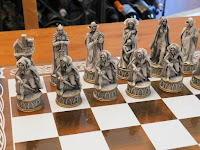While thinking about how I could use light to enhance a chess set, I stumbled across a 'vampires & werewolves' set on the www. Prices varied widely, and I managed to get a new set for a reasonable price.
The set on its own is already very nice, with the pieces of the vampire and werewolf armies well made from a type of resin, and with lots of detail.

This set was absolutely perfect for what I had in mind, and, I'll give it away now, it turned out exactly as I had envisioned.
First, I got myself two strings of LED xmas lights, green and red.

Then, I taped the lights under the white squares of the board, half of them green, half red. That left four pairs of lights to be attached to the four 'ruins' carrying the board.

Big moment: will switching on the lights give me what I had in mind?
It most surely did, so time to put the pieces back on the board!
The effect of the lights really creates a spooky atmosphere, green really fitting with vampires, and red with werewolves.
As I said above, I'm really pleased this came out the way I had envisioned it. Because the lights are under the white squares, they appear much more like a glow than single light points, sickly green in the vampire half, aggressive red in the werewolf half. The extra lights on the 'ruins' add to the atmosphere, resembling torches or beacons.
And to give you a better idea of what it looks like in a dark room, here's a brief video:
Of course, the set can be used to play chess according to FIDE rules, but there's a much more appropriate variant: Werewolf chess!


















